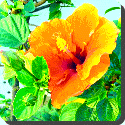 Hibiscus — Hibiscus, or rosemallow, is a large genus of about 200–220 species of flowering plants in the family Malvaceae (the mallow family, along with members like cocoa, cotton, okra, baobab and durian) native to warm temperate, subtropical and tropical regions throughout the world. The genus includes both annual and perennial herbaceous plants, and woody shrubs and small trees.
Hibiscus — Hibiscus, or rosemallow, is a large genus of about 200–220 species of flowering plants in the family Malvaceae (the mallow family, along with members like cocoa, cotton, okra, baobab and durian) native to warm temperate, subtropical and tropical regions throughout the world. The genus includes both annual and perennial herbaceous plants, and woody shrubs and small trees.
The leaves are alternate, simple, ovate to lanceolate, often with a toothed or lobed margin.
The flowers are large, conspicuous, trumpet-shaped, with five or more petals, ranging from white to pink, red, purple or yellow, and from 4-15 cm broad.
One species of Hibiscus, known as Kenaf (Hibiscus cannabinus), is extensively used in paper making. Another, roselle (Hibiscus sabdariffa) is used as a vegetable and to make herbal teas and jams (especially in the Caribbean). In Latin America, the drink is known as jamaica (drink) and is quite popular. It is made from calyces of the roselle plant. In Egypt and Sudan, roselle petals make a tea named after the plant, karkade.
The Hibiscus is used as an offering to Goddess Kali and Lord Ganesha in Hindu worship. The Gumamela or Hibiscus rosa sinensis linn flower has antifungal, emmenagogue, emollient and refrigerant effect. The bark of the hibiscus contains strong fibers. They can be obtained by letting the stripped bark sit in the sea in order to let the organic material rot away. In Polynesia these fibers are used for making grass skirts. They have also been known to be used to make wigs.
 Kids Portal For Parents India Kids Network
Kids Portal For Parents India Kids Network






